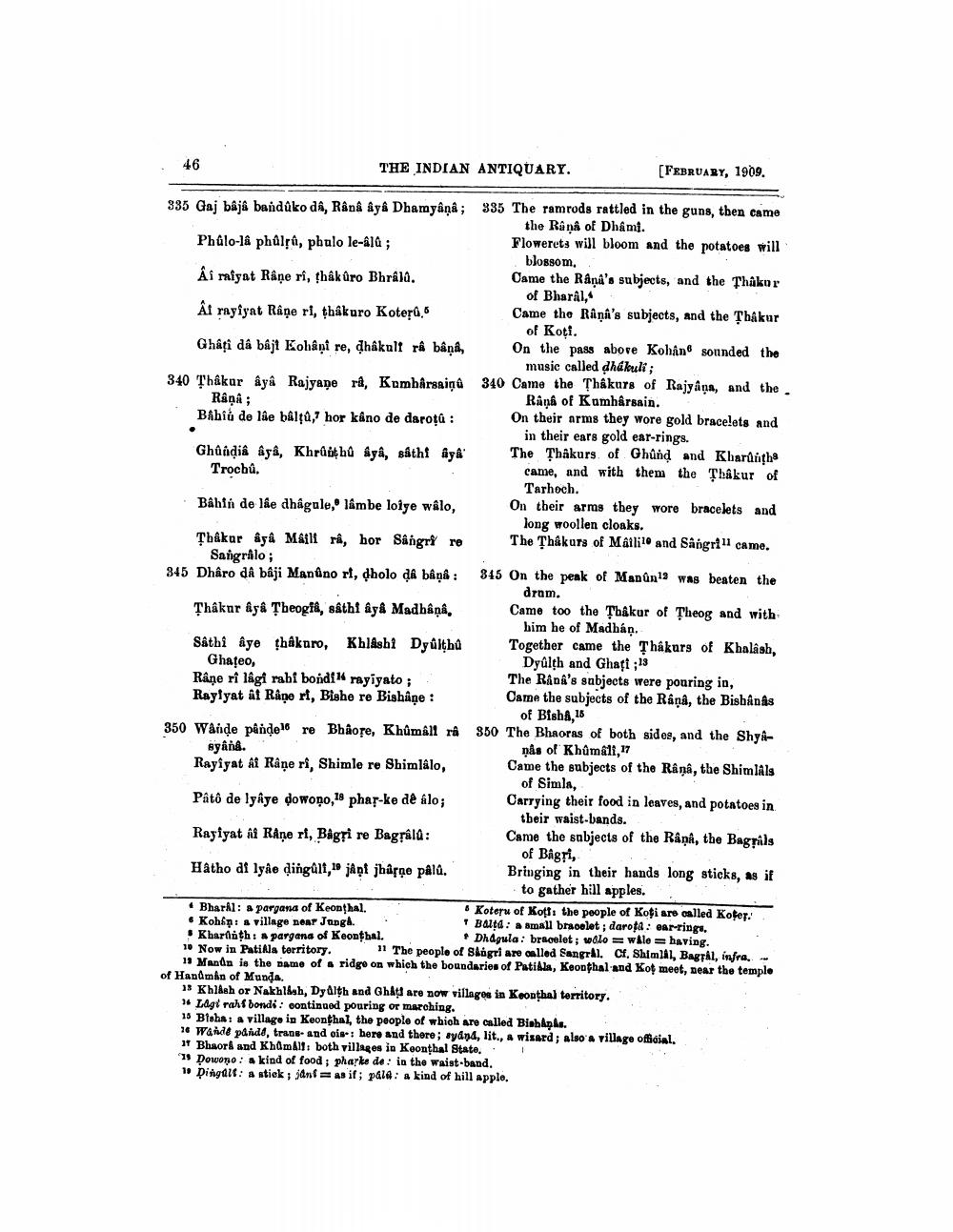________________
46
THE INDIAN ANTIQUARY.
(FEBRUARY, 1909.
335 Gaj baja bandůko da, Rânâ âyâ Dhamyânâ; 335 The ramrods rattled in the guns, then came
the Rånå of Dhami. Phâlo-lâ phůlţî, phulo le-ald ;
Flowerets will bloom and the potatoes will
blossom, Ai miyat Rape ri, thậk Dro Bhrala.
Came the Râna's subjects, and the Thakor
of Bharal, Ai rayfyat Râșe ri, thâkuro Kotera.“
Came the Rani's subjects, and the Thakur
of Koti. Ghâți dá bájt Kohâși re, dhâkult rå bâņa, On the pass above Kohan sounded the
music called dhákuli ; 340 Thakur âyâ Rajyapera, Kumbarsaiņā 340 Came the Thâkurs of Rajyána, and the Râņi;
Rânâ of Kumhârsain. Bahiu de lâe balta, hor käno de darota : On their arms they wore gold bracelets and
in their ears gold ear-rings. Ghuidiâ ayê, Khru thủ ágâ, sathi âyâ The Thâkurs of Ghûnd and Kharaithe Trochů.
came, and with them the Thâkur of
Tarhoch. Bahia de lâe dhagule, lâmbe loiye wâlo, On their arms they wore bracelets and
long woollen cloaks. Thükar aya Mal rá, hor Sängre re The Thákurs of Maililo and Sangriul came.
Sangralo; 845 Dharo dA baji Manano rf, dholo da bâņa: 345 On the peak of Manunta was beaten the
drom. Thâkar ásâ Theogid, sathi âyâ Madhâņa. Came too the Thakur of Theog and with
him he of Madhán. Sathi âye thakaro, Khlashi Dyalthů Together came the Thâkurs of Khalash, Ghafeo,
Dyúlth and Ghaçi :13 Râne rî lagi rabi bondi 4 rayiyato;.
The Rank's subjects were pouring in, Rayfyat at Råne ri, Bishe re Bishaạe : Came the subjects of the Râna, the Bisbanas
of Bish8,15 350 Wande pande16 re Bhâore, Khûmall ra 350 The Bhaoras of both sides, and the Shyasyana.
ņas of Khûmáli, 17 Rayiyat Al Râņe ri, Shimle re Shimlálo, Came the subjects of the Rânâ, the ShimlAls
of Simla, Pâtô de lyhye dowoņo, 18 phar-ke de alo; Carrying their food in leaves, and potatoes in
their waist-bands. Rayiyat i Råne ri, Bagri re Bagrala:
Came the subjects of the Rank, the Bagrils
of Bagri, Hatho di lyke ţinguli, japi jharạe pálů. Bringing in their hands long sticks, as if
to gather hill apples. • Bharll: a Pargana of Keonthal.
• Koteru of koff: the people of Koţi are called Koper. 6 Koháp: a village near Jung.
" Balta: a small bracelet; darota : earrings. ! Kharlith: pargans of Keontbal.
• Dhagula: bracelet; solo = wile = having. 10 Now in Patiala territory.
The people of Skagri are onlled Sangral.cf, Shimlil, Bagril, infra, 13 Manon is the name of a ridge on which the boundaries of Patiala, Keonthal and Kof meet, Dear the temple of Hanůmin of Munda.
1% Khlash or Nakhlsh, Dydlth and Ghat are now villages in Koonthal territory. # Lagi rah bondi : continued pouring or marching. 18 Bloha a village in Keonchal, the people of which are called Bishkpl. 16 Wandt paids, trans- and oir: here and there; sydna, lit., a wisard; also a village official IT Bhaorl and KhdmAll both villages in Koonthal State. 15 Dowono: a kind of food; pharks de: in the waist-band. 1Dingait: astiek; jan= us if; pale: a kind of hill apple.




